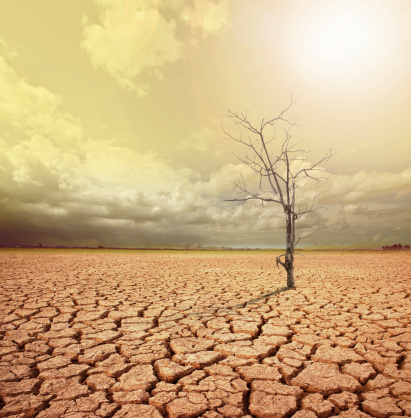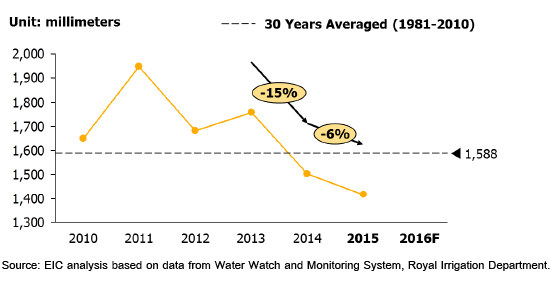Thailand’s drought crisis 2016: Understanding it without the panic
Thailand has experienced drought episodes almost every year, including the current one. This year, the agricultural sector will bear the largest impact, as the quantities of many agricultural products fall, especially rice, tapioca, sugarcane, and sugar. However, agricultural supply shortages may lead to price improvements for some crops.
Author: Teerayut Thaiturapaisan

|
Highlight
|
Thailand has faced drought situations almost every year, including the current one. It is commonly understood that most droughts are caused by climate change that leads to sub-average rainfall or aberrations in seasonal rainfall patterns, reducing accumulated rainfall from year to year. Interestingly, however, annual accumulated rainfall in Thailand has been above the 30-year average every year since 2011 until 2014 (Figure 1). This raises the question of why Thailand still experience repeated droughts almost every year during this period. According to data from the Land Development Department, areas of permanent droughts in Thailand still covers as much as 40% of total agricultural areas, suggesting that apart from the decline in rainfall, there are the other factors that contribute importantly to droughts in Thailand as well, such as water consumption behaviors, agricultural and industrial land development, and population growth. To make matters worse, in 2014 and 2015, annual accumulated rainfall in Thailand dipped below the 30-year average (1981-2010) for two consecutive years, causing a significant depletion of water supply across various reservoirs in 2016, leading to the current situation.
Each year, the agricultural sector is often the first to be affected by droughts as production declines, especially in rice crop. Most heavily affected crops this year is dry season rice (currently in harvesting season), over 3.4 million rai of which has already been grown throughout the country this year. Especially worrisome are areas in the Chaopraya river basin, with over 2 million rai at risk because usable water from the four major reservoirs (Bhumibol, Sirikit, Kwaenoi Bumrung Dan, and Pasak Cholasit) is only enough to cover human consumption and ecosystem protection (to prevent saltwater intrusion). Following dry season rice crop, tapioca, sugarcane, and sugar will also be affected by the drought in the current. Due to there was inadequate rainfall last year, which lead to yields per rai have fallen, affecting the quantities reduction that will be harvested in the first quarter of this year. According to data from the TDRI, the fall in agricultural production due to the drought will cause an approximately 20 billion baht loss in purchasing power among farmers, resulting in a more than 60 billion loss in the country’s overall purchasing power.
Global downturn in agricultural production this year might push agricultural price in some products to be above the previous year’s levels. Given that the El Nino phenomenon taking place across the globe in 2015-2016, is considered the most severe episode in 65 years, other major agricultural producers are also affected as well. The United States Department of Agriculture noted that the El Nino phenomena has led the global supply and demand of many agricultural products to fall into deficit, such as rice, sugar, and corn. Against such a backdrop, there is a possibility that agricultural prices in global markets will edge up this year. That being said, other factors may hinder price improvements and should be closely monitored. For instance, the release of rice from government stockpile (rice), the decline in global crude oil price (natural rubber), the determination of the Chinese government’s buying price for corns (tapioca), as well as the depreciation of various foreign currencies.
Industrial and tourism sectors, as well as human consumption, are likely no impact from the effect of drought this year. Given the 2,731 million cubic meters of useable water in the four major reservoirs, as of 13 March 2016, and the Royal Irrigation Department’s plan to release water a total of approximately 18-19 million cubic meters per day, water supply in the current will last around 150 more days or until the end of July 2016. The United States National Oceanic and Atmospheric Administration (NOAA) expects that the severity of El Nino to gradually decline, and the climate to resume neutral conditions in the middle of 2016 (with a 50% probability). Subsequently, rainfall in Thailand will resume its normal pattern, and drought conditions should get better from July onwards. Meanwhile, although the amount of water will be sufficient for the industrial, and tourism sectors, as well as human consumption until the end of July, all parties, including the government, the private sectors, and individuals should unite in order to together bring about a coherent solution to fighting this year’s drought crisis.
An important risk to be monitored is the possibility that after July there remains insufficient rainfall to refill the reservoirs as expected. Such a situation would cause an extreme drought crisis in Thailand. If such is the case, it is possible that the impact of the drought will expand further, encroaching the industrial, and tourism sectors, as well as the supply of water for human consumption. According to Suan Dusit poll results surveying the opinions of the general public regarding the drought situation, over 50% of respondents were concerned about the problem in the current, suggesting the potential for future water resources conflicts. Therefore, apart from the government’s policy plans and measures to mitigate drought impact, EIC suggests that preparation for the risk of drought in the second half of the year should be a high priority to prevent the severity of any impact from escalating.
EIC believes that every cloud has a silver lining. So with the drought crisis comes water-related business opportunities. Businesses related to water management, electronics equipments and systems for water technology, as well as other water-related businesses will be in high demand in the near future. Moreover, farmers who can adapt their agricultural lands to meet changing water resource conditions can start new businesses through knowledge-sharing with other farmers as the consultant.
|
|
|
|
|
|
Figure 1: Cumulated rainfall in Thailand between 2010 and 2015 |
||
 |
||
|
Source: EIC analysis based on data from Water Watch and Monitoring System, Royal Irrigation Department. |